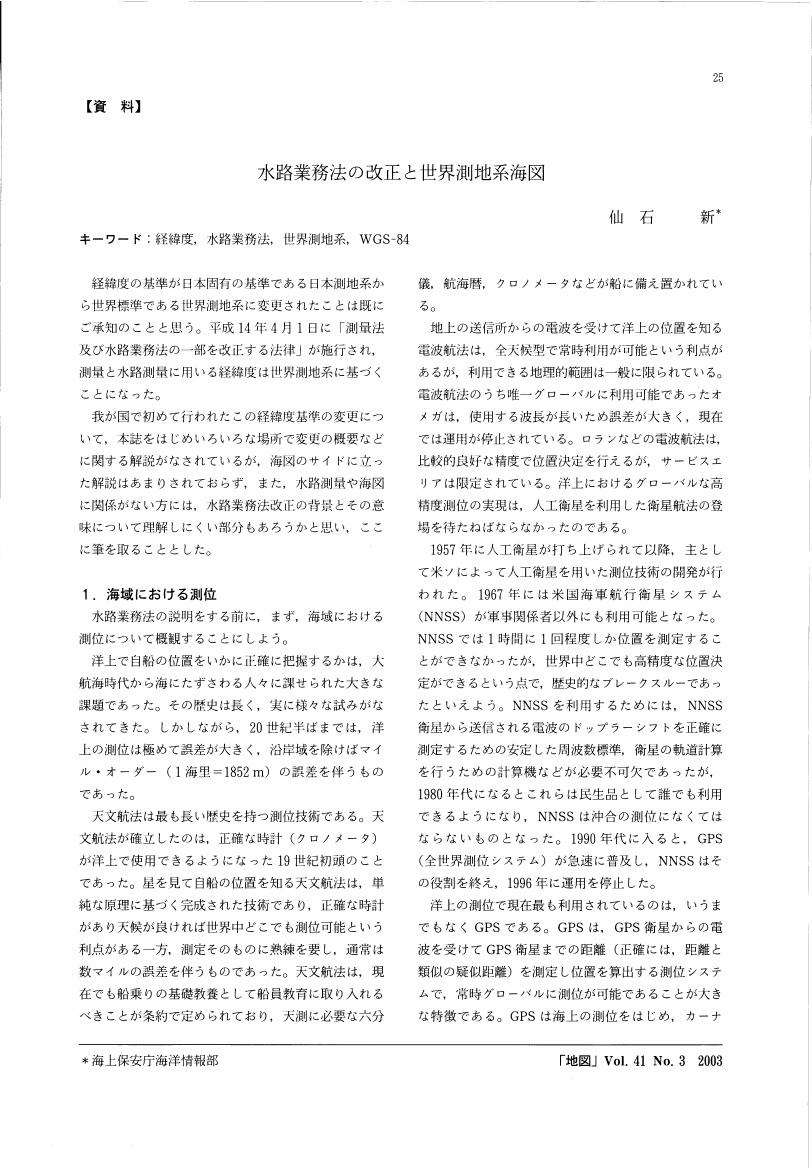3 0 0 0 OA 我が国の狭水道と瀬戸内海における潮流発電ポテンシャルマップ
- 著者
- 仙石 新 石田 雄三 杉尾 毅
- 出版者
- 海洋調査技術学会
- 雑誌
- 海洋調査技術 (ISSN:09152997)
- 巻号頁・発行日
- vol.23, no.2, pp.2_1-2_8, 2011 (Released:2011-11-11)
- 参考文献数
- 11
Tidal stream power is renewable energy which is free from hydrocarbon energy source and CO2 emission. In Japan, we have several narrow passages with strong tidal current, more than 10 knots in some cases, and tidal stream power may be utilized in the future, which contributes to reduction of global warming gas. In this paper, we estimate distribution of tidal stream power density in several narrow passages and Setonaikai in Japan from amplitude of M2 and S2 constituents of tidal stream.
2 0 0 0 OA 世界測地系への円滑な移行
- 著者
- 村上 真幸 仙石 新
- 出版者
- 日本測地学会
- 雑誌
- 測地学会誌 (ISSN:00380830)
- 巻号頁・発行日
- vol.53, no.1, pp.1-12, 2007-03-25 (Released:2011-03-01)
- 参考文献数
- 21
This paper describes the background of, and the necessity for the transition of the Japanese national geodetic datum from Tokyo Datum to the geocentric geodetic datum (or world geodetic system). Historically, the shape and scale of an earth ellipsoid have become accurately determined with the development of artificial satellites and laser ranging technique, and the position of an earth ellipsoid relative to the earth has been accurately determined by space geodetic techniques such as VLBI, SLR and GPS. As a result, at the end of the twentieth cen tury, geocentric geodetic datums, ITRF and WGS 84, were established and many international organizations recommend adopting ITRF or WGS 84 as the standard datum. Recent prevail ing use of GPS in surveying and navigation reveals the difference between traditional datum and geocentric datum to users of maps and charts. To leave the difference as it is would make confusion and could cause an accident if one makes positioning by GPS based on geocentric datum while using maps/charts based on traditional datum. Transition of datum from traditional one to geocentric one appears inevitable. Two governmental organizations, the Geographical Survey Institute (GSI) and the Hydrographic and Oceanographic Department of Japan Coast Guard (JHOD) made much effort to realize a new Japanese geodetic datum basedon a geocentric datum and develop maps and charts (both paper-based and digital ones) referenced to the new datum. They also collaborated to have relevant laws (Survey Act and Law for Hydrographic Activities) to be amended which regulate the geodetic datum to be used in Japan. The amended laws became effective on April 1, 2002, and the datum change was propagated among Japan without serious troubles owing to extensive preparations.
1 0 0 0 OA 海図って何? ―その役割と未来-
- 著者
- 仙石 新
- 出版者
- 日本地図学会
- 雑誌
- 地図 (ISSN:00094897)
- 巻号頁・発行日
- vol.56, no.3, pp.19-26, 2018-09-30 (Released:2020-01-24)
- 参考文献数
- 3
1 0 0 0 世界測地系への円滑な移行
- 著者
- 村上 真幸 仙石 新
- 出版者
- 日本測地学会
- 雑誌
- 測地学会誌 (ISSN:00380830)
- 巻号頁・発行日
- vol.53, no.1, pp.1-12, 2007
This paper describes the background of, and the necessity for the transition of the Japanese national geodetic datum from Tokyo Datum to the geocentric geodetic datum (or world geodetic system). Historically, the shape and scale of an earth ellipsoid have become accurately determined with the development of artificial satellites and laser ranging technique, and the position of an earth ellipsoid relative to the earth has been accurately determined by space geodetic techniques such as VLBI, SLR and GPS. As a result, at the end of the twentieth cen tury, geocentric geodetic datums, ITRF and WGS 84, were established and many international organizations recommend adopting ITRF or WGS 84 as the standard datum. Recent prevail ing use of GPS in surveying and navigation reveals the difference between traditional datum and geocentric datum to users of maps and charts. To leave the difference as it is would make confusion and could cause an accident if one makes positioning by GPS based on geocentric datum while using maps/charts based on traditional datum. Transition of datum from traditional one to geocentric one appears inevitable. Two governmental organizations, the Geographical Survey Institute (GSI) and the Hydrographic and Oceanographic Department of Japan Coast Guard (JHOD) made much effort to realize a new Japanese geodetic datum basedon a geocentric datum and develop maps and charts (both paper-based and digital ones) referenced to the new datum. They also collaborated to have relevant laws (Survey Act and Law for Hydrographic Activities) to be amended which regulate the geodetic datum to be used in Japan. The amended laws became effective on April 1, 2002, and the datum change was propagated among Japan without serious troubles owing to extensive preparations.
1 0 0 0 OA 水路業務法の改正と世界測地系海図
- 著者
- 仙石 新
- 出版者
- 日本地図学会
- 雑誌
- 地図 (ISSN:00094897)
- 巻号頁・発行日
- vol.41, no.3, pp.25-31, 2003-10-30 (Released:2011-07-19)
- 参考文献数
- 7

